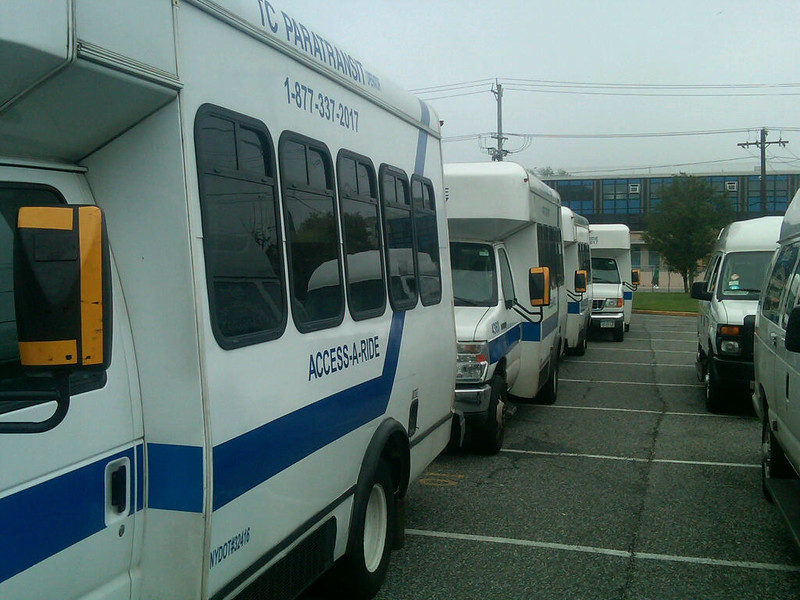
(photo: MTA)
There is a reason why Access-A-Ride is better known as “Stress-A-Ride” for the approximately 170,000 New Yorkers who depend on it.
The bill for Access-A-Ride will hit $616 million this year and the MTA is seeking additional funding from the City of New York. It’s mind-boggling to think this service can cost the cash-strapped agency so much for such low-quality service. That’s why before anyone kicks in additional funding, the MTA must fundamentally transform the way it runs its paratransit program and bring it into the 21st century.
New York City Transit (NYCT), which is part of the MTA, administers paratransit service, which provides 24/7 shared-ride, door-to-door transportation through the five boroughs and in parts of Westchester and Long Island. The scale and scope of this service is unmatched by any other transit system in the nation. However, disability advocates and budget watchdog groups alike have observed for years that the MTA’s byzantine approach to paratransit services leads to inefficiencies and a lack of transparency and accountability, culminating in the highest cost-per-trip ($68.71) in the country. The second most expensive (Chicago) is half the MTA’s at $38. Why?
Fundamentally, the way the MTA contracts its paratransit services is both cumbersome and inefficient. Right now, the MTA provides Access-A-Ride through a constellation of for-profit and not-for-profit contractors, including 13 Dedicated Carriers, which use specially-equipped buses and cars owned by NYCT, and two Broker Car Service Providers, which provide transportation services to ambulatory passengers through a network of subcontracted livery and black car service providers.
And there are separate contracts that govern Access-A-Ride’s eligibility determination unit, the command center which receives trip requests and designs schedules and routes, and the carriers that complete those trips. Is your head spinning yet?
In addition, more than half of Access-A-Ride trips are “ambulatory” for people who are able to walk to, enter, and exit vehicles without assistance. Vehicles with special equipment are not necessary for these trips. Putting people in taxis or other for-hire vehicles is cheaper. A single trip under the e-hail program costs the authority $35.91. The same Access-A-Ride trip costs the MTA $68.71.
So how could we turn things around for Access-A-Ride?
Instead of over a dozen contractors and vendors to provide paratransit services, the MTA should unify the entire system with a single, full-service technology platform to handle all relationships with vehicle providers. The MTA could streamline management of Access-A-Ride and ambulatory services, encourage more competitive bidding, and lower administrative costs.
In the last five years, reports by experts at the Citizens Budget Commission, NYU Rudin Transportation Center, and Comptroller Scott Stringer’s office all point to the burdensome administrative and coordination layers that are the direct result of multiple types of contracts and vendors at every step of the service: verification, booking, dispatching, routing, vehicle operations, customer service, etc.
While they’re at it, the MTA should require that this platform enable on-demand rides in real-time so that people are no longer forced to call to reserve a trip one to two days in advance and wait to be given an unpredictable and often inaccurate pickup time.
We should have a system to match paratransit customers to right-sized vehicles from a variety of modes; increase efficient sharing and routing of vehicles; and create more transparency and accountability for quality-of-service and customer complaints. The technology for this solution is well-established and the MTA should begin the work immediately to transition to such a system.
In the meantime, it should build on the success of the e-hail program – the MTA’s one innovation in this space in recent memory – instead of curtailing it. The pilot provided the city’s paratransit customers with rides in yellow or green taxis through an e-hail app, Curb or Arro, but was only made available to 1,200 users, less than 1% of the service’s customers. The MTA is now looking to severely limit the one bright spot in its paratransit program by capping rides and having customers pay more. It should instead improve the program.
Most of the rides currently booked through the e-hail pilot are single-passenger rides, but where appropriate we should use ride-matching technology to have more multi-passenger ambulatory trips as a way to lower cost-per-trip.
The MTA recently held a conference inviting technology companies to share ideas for slashing time and cost of modernizing the antiquated signal system in the subway. Mark Dowd, the new Chief Innovation Officer at the MTA, declared, “We are looking for cutting-edge technologies, technologies that may have not been designed for this purpose, but can be applied to this purpose.” The MTA needs to apply this type of thinking to transform the costly and antiquated paratransit program. Now.
***
City Council Member Justin Brannan represents parts of Brooklyn; City Council Member Diana Ayala represents parts of Manhattan and the Bronx. On Twitter @JustinBrannan and @DianaAyalaNYC.
***
Have an op-ed idea or submission for Gotham Gazette? Email This email address is being protected from spambots. You need JavaScript enabled to view it.